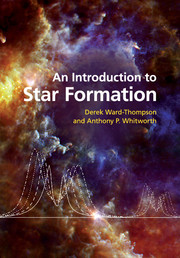Book contents
- Frontmatter
- Contents
- List of Illustrations
- Preface
- 1 Introduction
- 2 Probing star formation
- 3 The ISM – the beginnings of star formation
- 4 Molecular clouds – the sites of star formation
- 5 Fragmentation and collapse – the road to star formation
- 6 Young stars, protostars and accretion – building a typical star
- 7 The formation of high-mass stars, and their surroundings
- 8 By-products and consequences of star formation
- List of mathematical symbols
- List of figure credits
- Index
- References
8 - By-products and consequences of star formation
Published online by Cambridge University Press: 05 June 2012
- Frontmatter
- Contents
- List of Illustrations
- Preface
- 1 Introduction
- 2 Probing star formation
- 3 The ISM – the beginnings of star formation
- 4 Molecular clouds – the sites of star formation
- 5 Fragmentation and collapse – the road to star formation
- 6 Young stars, protostars and accretion – building a typical star
- 7 The formation of high-mass stars, and their surroundings
- 8 By-products and consequences of star formation
- List of mathematical symbols
- List of figure credits
- Index
- References
Summary
Introduction
In this chapter we discuss some of the phenomena observed as a consequence of star formation. We describe some of the phenomena surrounding star formation, such as discs, outflows, and binary and multiple stars, and we discuss the difference between hydrogen-burning stars and brown dwarf stars.
We then go on to detail some of the larger-scale consequences, such as how star formation affects the host galaxy in which it occurs. In this context we also discuss starburst galaxies and galaxy mergers. Finally, we outline current understanding on when the major epoch of star formation occurred in the Universe.
Circumstellar discs
In Chapter 6 we discussed accretion onto protostars. In particular, we discussed spherically symmetric accretion. However, if the material accreting onto a protostar has angular momentum (and in general it does), the infall is not spherically symmetric, nor is it direct. Instead, the material accumulates in a circumstellar disc, and then spirals inwards onto the equator of the star on a time-scale determined by the efficiency of the processes which redistribute or remove the angular momentum in the disc. Such a disc is often termed an accretion disc. We also mentioned this in Chapter 7 as a method for increasing the accretion onto a high-mass protostar in the context of significant radiation pressure potentially halting the accretion.
- Type
- Chapter
- Information
- An Introduction to Star Formation , pp. 173 - 194Publisher: Cambridge University PressPrint publication year: 2011



